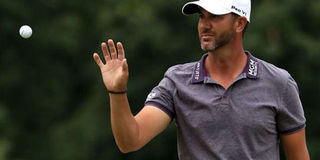The most important element in golf is the ball

Scott Piercy catches a ball on the 13th green during the third round of the World Golf Championships - Bridgestone Invitational at Firestone Country Club South Course on July 2, 2016 in Akron, Ohio. PHOTO | SAM GREENWOOD |
What you need to know:
- One Kenyan golfer whom I have had the pleasure of playing with has his picture emblazoned on his golf balls.
- In 1902, the newly-formed Rules of Golf Committee laid the foundation of the modern Rules in as far as the Wrong Ball is concerned. In match play, the player who played the Wrong Ball lost the hole.
- However, the golfer who played the Wrong Ball in stroke play, was not penalised if he went back and played the correct ball.
- The loophole was closed in 1934 with introduction of the two-stroke penalty. The Rules then still had a lot of grey areas and over the years these have been cleared.
The most important item in the game of golf is the ball. In the Rules of Golf, the small white object that many golfers would like to propel 300 yards straight down the middle of the fairway is mentioned at least 155 times. It is perhaps the most abundant commodity on the golf course. This was not always the case.
In the 17th century, the “feathery” superseded the wooden missile that was the earliest known ball. The ball, that was filled with as many poultry feathers as it took to fill an entire top hat to the brim, was expensive and easily damaged. Despite its drawbacks, the feathery did noble service for over 200 years.
In 1848, a dramatic change came with the arrival of the gutta percha, a rubber like substance from the percha tree. It was malleable when boiled and even when misshapen or broken, the parts could be reshaped after re-boiling. The reign of the gutta percha ball lasted until the introduction of the rubber core at the start of the 20th century.
Nowadays the golf world is filled with small white balls that are indistinguishable from a close distance. Looked at more closely they are seen to bear brand names and numbers. Some belonging to careful golfers may have some coloured dots or lines to differentiate them.
One Kenyan golfer whom I have had the pleasure of playing with has his picture emblazoned on his golf balls.
Instead of making certain of ownership before playing, many times golfers will jump to conclusions based on probabilities. Even when the brand names and numbers are examined, it can happen that two or more balls in use in the same group, or a stray ball outside the group, bear identical markings.
So, by human carelessness or force of circumstances unwitting breaches of the Wrong Ball rule frequently occur. The penalties are loss of hole in match play or two-stroke penalty in stroke play and the player MUST play the correct ball otherwise he is disqualified. The strokes made at the Wrong Ball are not counted.
The golfers who played the feathery did not have the same problem. The feathery had distinctive characteristics depending on the craftsman and the use. It was not until 1839 when there was official reference to playing the wrong ball. Even then, the Rules were lenient and the only serious breach was moving of an opponent’s ball (match play) and that the playing of a stray ball was considered a “Rub of the Green” and no penalty was incurred.
In 1902, the newly-formed Rules of Golf Committee laid the foundation of the modern Rules in as far as the Wrong Ball is concerned. In match play, the player who played the Wrong Ball lost the hole.
However, the golfer who played the Wrong Ball in stroke play, was not penalised if he went back and played the correct ball. The committee did not imagine that a golfer could be so perverse as to use this latitude to assist him in getting some useful practice strokes without penalty.
The loophole was closed in 1934 with introduction of the two-stroke penalty. The Rules then still had a lot of grey areas and over the years these have been cleared.
It is interesting to see that some of the proposals made in the 1950s in this regard are still in force to date. One such note from 1954 that is still in force until now is, when the player and the opponent exchange balls, the first to play the wrong one shall lose the hole; when this cannot be determined the hole shall be played out with the balls thus exchanged.
Many modern-day golfers are not aware of the fact that a ball is not ‘in play’ between the finish of one hole and the start of the next. I have heard of a player who was penalised for changing his ball on a hole with a water hazard.
He was accused of playing a Wrong Ball from the teeing ground in his attempt to avoid losing his ‘new’, expensive, soft ball in the water hazard. He was required to return to the tee and play the expensive brand, which he promptly lost in the water.
Before starting a round of golf, it is usual for golfers to announce the brand and number of the ball they are using. Trouble usually starts during the round when a player, through loss or damage, puts another ball in play.
If this happens to be identical in brand and number to another ball and the players cannot distinguish their own, then the balls are lost and the players must return to the place where they played the last shot. A golfer who makes a stroke at such a ball has played the Wrong Ball.
[email protected] The author is a Kenya Golf Union Executive




